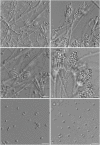Genome Sequencing and Comparative Genomics Analysis Revealed Pathogenic Potential in Penicillium capsulatum as a Novel Fungal Pathogen Belonging to Eurotiales
- PMID: 27761131
- PMCID: PMC5051111
- DOI: 10.3389/fmicb.2016.01541
Genome Sequencing and Comparative Genomics Analysis Revealed Pathogenic Potential in Penicillium capsulatum as a Novel Fungal Pathogen Belonging to Eurotiales
Abstract
Penicillium capsulatum is a rare Penicillium species used in paper manufacturing, but recently it has been reported to cause invasive infection. To research the pathogenicity of the clinical Penicillium strain, we sequenced the genomes and transcriptomes of the clinical and environmental strains of P. capsulatum. Comparative analyses of these two P. capsulatum strains and close related strains belonging to Eurotiales were performed. The assembled genome sizes of P. capsulatum are approximately 34.4 Mbp in length and encode 11,080 predicted genes. The different isolates of P. capsulatum are highly similar, with the exception of several unique genes, INDELs or SNPs in the genes coding for glycosyl hydrolases, amino acid transporters and circumsporozoite protein. A phylogenomic analysis was performed based on the whole genome data of 38 strains belonging to Eurotiales. By comparing the whole genome sequences and the virulence-related genes from 20 important related species, including fungal pathogens and non-human pathogens belonging to Eurotiales, we found meaningful pathogenicity characteristics between P. capsulatum and its closely related species. Our research indicated that P. capsulatum may be a neglected opportunistic pathogen. This study is beneficial for mycologists, geneticists and epidemiologists to achieve a deeper understanding of the genetic basis of the role of P. capsulatum as a newly reported fungal pathogen.
Keywords: Penicillium capsulatum; comparative genomics; genome sequencing; novel fungal pathogen.
Figures





Similar articles
-
Genomics and Comparative Genomic Analyses Provide Insight into the Taxonomy and Pathogenic Potential of Novel Emmonsia Pathogens.Front Cell Infect Microbiol. 2017 Mar 31;7:105. doi: 10.3389/fcimb.2017.00105. eCollection 2017. Front Cell Infect Microbiol. 2017. PMID: 28409126 Free PMC article.
-
A Robust Phylogenomic Time Tree for Biotechnologically and Medically Important Fungi in the Genera Aspergillus and Penicillium.mBio. 2019 Jul 9;10(4):e00925-19. doi: 10.1128/mBio.00925-19. mBio. 2019. PMID: 31289177 Free PMC article.
-
The Evolution of Orphan Regions in Genomes of a Fungal Pathogen of Wheat.mBio. 2016 Oct 18;7(5):e01231-16. doi: 10.1128/mBio.01231-16. mBio. 2016. PMID: 27795389 Free PMC article.
-
Modern taxonomy of biotechnologically important Aspergillus and Penicillium species.Adv Appl Microbiol. 2014;86:199-249. doi: 10.1016/B978-0-12-800262-9.00004-4. Adv Appl Microbiol. 2014. PMID: 24377856 Review.
-
[Intraspecific chromosomal variability in human pathogenic fungi, especially in Histoplasma capsulatum].Rev Iberoam Micol. 2004 Dec;21(4):168-76. Rev Iberoam Micol. 2004. PMID: 15709795 Review. Spanish.
Cited by
-
In Vivo Microevolutionary Analysis of a Fatal Case of Rhinofacial and Disseminated Mycosis Due to Azole-Drug-Resistant Candida Species.J Fungi (Basel). 2023 Aug 2;9(8):815. doi: 10.3390/jof9080815. J Fungi (Basel). 2023. PMID: 37623586 Free PMC article.
-
Secondary metabolites of the genus Penicillium from undisturbed and anthropogenically altered Antarctic habitats.Folia Microbiol (Praha). 2020 Feb;65(1):95-102. doi: 10.1007/s12223-019-00708-0. Epub 2019 Apr 13. Folia Microbiol (Praha). 2020. PMID: 30982204
-
Systematic identification of CAZymes and transcription factors in the hypercellulolytic fungus Penicillium funiculosum NCIM1228 involved in lignocellulosic biomass degradation.Biotechnol Biofuels Bioprod. 2023 Oct 4;16(1):150. doi: 10.1186/s13068-023-02399-9. Biotechnol Biofuels Bioprod. 2023. PMID: 37794424 Free PMC article.
-
Morphological and phylogenetic analyses reveal two new Penicillium species isolated from the ancient Great Wall loess in Beijing, China.Front Microbiol. 2024 Mar 15;15:1329299. doi: 10.3389/fmicb.2024.1329299. eCollection 2024. Front Microbiol. 2024. PMID: 38559343 Free PMC article.
-
Genomics and Comparative Genomic Analyses Provide Insight into the Taxonomy and Pathogenic Potential of Novel Emmonsia Pathogens.Front Cell Infect Microbiol. 2017 Mar 31;7:105. doi: 10.3389/fcimb.2017.00105. eCollection 2017. Front Cell Infect Microbiol. 2017. PMID: 28409126 Free PMC article.
References
-
- Amich J., Vicentefranqueira R., Leal F., Calera J. A. (2010). Aspergillus fumigatus survival in alkaline and extreme zinc-limiting environments relies on the induction of a zinc homeostasis system encoded by the zrfC and aspf2 genes. Eukaryot. Cell 9 424–437. 10.1128/EC.00348-09 - DOI - PMC - PubMed
-
- Bhabhra R., Miley M. D., Mylonakis E., Boettner D., Fortwendel J., Panepinto J. C., et al. (2004). Disruption of the Aspergillus fumigatus gene encoding nucleolar protein CgrA impairs thermotolerant growth and reduces virulence. Infect. Immun. 72 4731–4740. 10.1128/IAI.72.8.4731-4740.2004 - DOI - PMC - PubMed
LinkOut - more resources
Full Text Sources
Other Literature Sources
Miscellaneous

